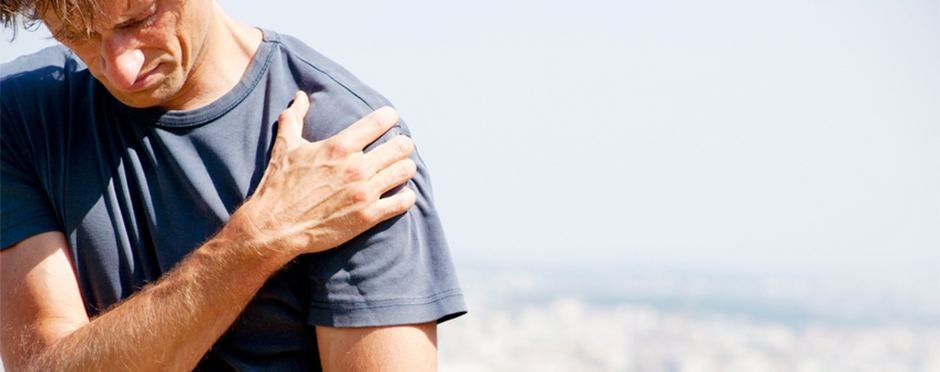
3 Essential Exercises for Shoulder Stability
1 CommentThe shoulder is a complex joint that consists of a “ball” on one side and a “socket” on the other. Due to this construction, the shoulder is classified as “ball-and-socket” joint. To gain a better perspective on the size of this ball-and-socket joint, think of a golf ball sitting on a tee. On one side you have a really large ball and the other a small socket. The proportions of this large ball and small socket allows for the shoulder joint to have the largest amount of motion of any joint in the body, but there is a price to pay for this amount of motion.
Because the shoulder enjoys so much freedom of motion there is a certain amount of inherent instability in it. Yet, experience tells you that your shoulders don’t fall apart whenever you try and use them. This is prevented by the surrounding shoulder musculature providing the crucial stability it needs during movement. Without this dynamic stability, your shoulders would be in big trouble.
Many of these stabilizing muscles are found on and around your shoulder blade. This means your shoulder blade has an important role in restoring or maintaining the shoulder function, and exercises focusing on this area are critical for proper shoulder stability.1 Here are three shoulder blade exercises that can help build your shoulder “core” to provide superior shoulder stability:
- If you are currently experiencing shoulder pain, it is recommended to first have your shoulder examined before performing these exercises.
Dynamic Hug – Serratus Anterior Strengthening
Stand with one foot in front of the other and the resistance band around your back or secured behind you. Start with your elbows bent and your hands at chest height. Straighten your elbows while simultaneously reaching as far forward as you can, bringing your hands together at the end of the movement. During this exercise, your arms should be parallel or just slightly above parallel to the ground.
 |
 |
The key to this exercises is to make sure you are reaching as far forward as you can, performing a ”punching” motion. This exercise focuses on strengthening the serratus anterior, which is an important muscle in providing proper shoulder blade upward rotation that is needed for proper shoulder function.
Prone Y- Lower Trapezius Strengthening
Lie on your stomach with one arm off the table or bench and your hand pointed toward the ground. Raise your arm on a 45 degree angle until it is parallel to the ground. When you are performing this exercise, squeeze the lower portion of your shoulder blade toward your spine. Pause for a moment before returning to your starting position.
 |
 |
To advance this exercise, perform both arms simultaneously while on a stability ball. During this advanced exercise, keep your neck in good alignment by not looking forward. Instead, look at the ground a few feet in front of you.
This exercise focuses on strengthening the lower trapezius. This muscle is not only important for performing shoulder blade upward rotation, but also is involved in bringing your shoulder blade down and in toward the middle of your back.
Stability Ball High Row with External Rotation – Middle Trapezius, Infraspinatus, and Teres Minor
 |
 |
 |
Sit on a stability ball (hips and knees at 90 degrees) with a resistance band secured in front of you. Start with your arms in front of you at shoulder height. Perform a row, squeezing your shoulder blades together. When your elbows are in line with your shoulders, rotate your shoulders so that your hands are now toward the ceiling. Return to the starting position by reversing the sequence.
This exercise strengthens the middle trapezius, which is important for bringing the shoulder blades together. The exercise also strengthens the infraspinatus and teres minor, which are important muscles for stabilizing the shoulder during movement.
Increasing Shoulder Stability
Adding these three exercises into your shoulder routine can assist with proper shoulder blade mechanics and help maintain proper shoulder stability. If you experience unusual aches and pains during exercise, make sure to schedule a free assessment at your nearest Athletico location.
The Athletico blog is an educational resource written by Athletico employees. Athletico bloggers are licensed professionals who abide by the code of ethics outlined by their respective professional associations. The content published in blog posts represents the opinion of the individual author based on their expertise and experience. The content provided in this blog is for informational purposes only, does not constitute medical advice and should not be relied on for making personal health decisions.
References
1. Kibler WB. The Role of the Scapula in Athletic Shoulder Function. The American Journal of Sports Medicine. 1998; 26(2): 325-337

1 Comment
Stella Mary
Amazing exercises. The pics and the explanations make it more clear to understand. Thank you for sharing.